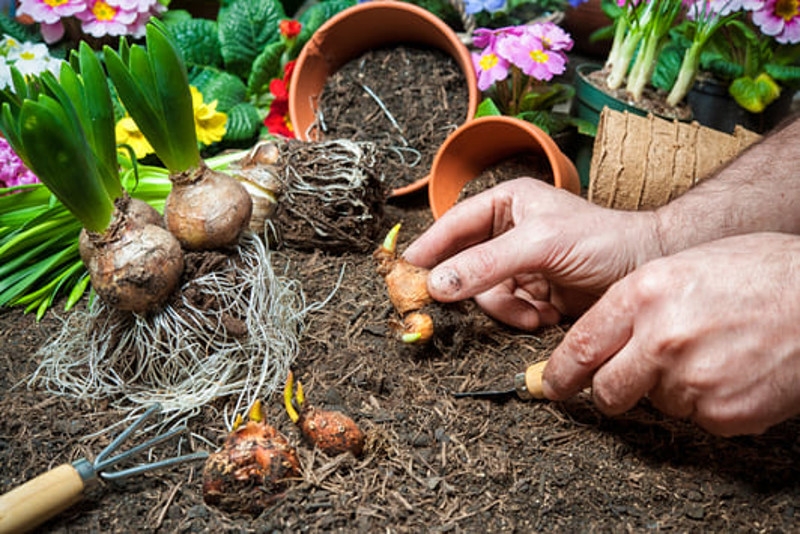
Tulips.
Hyacinths.
Dahlias.
What do all these plants have in common?
First of all, its flowers are beautiful.
And the second thing is that all of them are flowering bulbs. A very particular species of plant that includes many species.
We are going to talk to you about these plants in this post.
Here is a complete guide on how to care for flowering bulbs.
But, let us start at the beginning…
What are flowering bulbs?
The name says it all.
Flowering bulbs are a special type of plants that are characterized because the “core” of the plant is a bulb. A kind of underground organ covered by several protective layers.
This bulb retains moisture and contains numerous vital nutrients.
And here's the interesting thing.
In some cases, bulbous plants can lose the entire upper part of the plant and be left with only the bulb during their dormant period.
But once it finishes (which will be in spring or autumn depending on the species) it will bloom normally again. To do this, it takes advantage of the nutrients and water that has been stored in the bulb.
That is why they are very versatile and resistant plants, which can adapt to different conditions.
Of course: as always, to take care of your bulbous plants you have to know your needs very well.
How do you care for flowering bulbs?
There are many different species of bulbous.
And of course, each one of them will require specific care, and when it comes to growing them you should thoroughly inform yourself about them.
But broadly speaking we can talk about some common care for most bulbous plants.
1. Soil conditions
Good soil is a vital condition for caring for any type of plant. But it is especially important in the case of flowering bulbs.
It is essential that the substrate where we plant them has excellent drainage. Otherwise, excess moisture will rot the bulb and cause the plant to die.
If the soil in which you plant your bulbous plants has a large amount of clay, you will have to mix it with sand or gravel to facilitate the passage of water.
2. When to plant bulbous plants
Bulbous plants should always be planted during the dormant season.
As we told you, this will vary depending on the plant and when it blooms:
If it blooms between winter and spring: you will have to plant them during the fall.
If it flowers in autumn: these are less common, but species that flower during autumn (or even late summer) begin their dormant period in spring, and this is when you should plant them.
We continue.
3. How deep to plant them
This will vary greatly depending on the species.
There are some that only need to be about 5 centimeters from the ground, while others should be up to 20 centimeters deep.
You must inform yourself very well about the optimal cultivation depth for each species, because if you go too far or go too short, the plant may not be able to root and flower.
Also, if you plant it in a pot, make sure you use one large enough so that the bulb can develop its roots.
4. Irrigation: be careful with excess watering
As we told you, excess water is a serious danger for bulbous plants.
At first, when it is germinating, they will need more frequent watering, but once it has rooted and flowered you will have to reduce the frequency.
Also, once they are preparing to enter their dormant period, you will have to stop watering them.
Depending on the species, you will have to water your plant more or less frequently.
5. of the best flowering bulbs
Finally, we are going to see some of the most beautiful bulbous plants that you can plant at home.
1. Lilium orientalis
Lilium orientalis is a species of lily.
Its enormous flowers can measure up to 30 centimeters in diameter, and appear during summer and early autumn. They come in different variants, with white, pink or variocolor colors.
It is a quite rustic plant that is usually used in borders and flowerbeds.
2. Zantedeschia aethiopica
The water lily or calla lily is a bulbous plant from southern Africa.
It is a flower with a very intense aroma, and very characteristic funnel-shaped flowers, which is why it is often used for ornamental reasons. Blooms in mid-spring
3. Hippeastrum
This genus of bulbous plants has a huge variety of species (more than 75!).
During spring they display enormous spring-shaped flowers, with very striking yellow stamens. The flowers can emerge in different colors such as red, pink or white, either separately or combined
4. Gladiolus
Some beautiful bulbous plants whose flowers grow in the shape of a spike.
The gladiolus blooms in spring, and its beautiful flowers can last until the end of summer if we take good care of them.
5. Dahlia
One of the best-known bulbous plants is the dahlia.
This flower stands out for the curious shape of its flowers, composed of a multitude of petals and which emerge in different colors. In addition, they give off a very pleasant aroma.
Can we help you take care of your bulbous plants?
We hope you found this article useful and that it gives you some general ideas on caring for flowering bulbs.
Remember that if you have any questions, just write to us.
We will be happy to help you keep your plants healthy and happy.

 English
English Spanish
Spanish